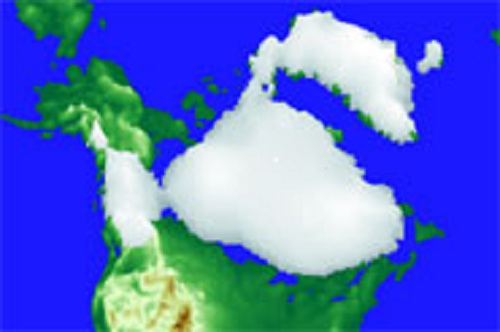Trigger for past rapid sea level rise discovered
Posted on 23 July 2012 by John Hartz
This is a reprint of a news release posted by the University of Bristol (UK) on July 11, 2012.
![]()
The cause of rapid sea level rise in the past has been found by scientists at the University of Bristol using climate and ice sheet models. The process, named ‘saddle-collapse’, was found to be the cause of two rapid sea level rise events: the Meltwater pulse 1a (MWP1a) around 14,600 years ago and the ‘8,200 year’ event. The research was published in the July 12 issue of Nature.

North American ice sheet during the saddle collapse, 14,600 years ago, simulated in this study. Image by Dr Lauren Gregoire.
Using a climate model, Dr Lauren Gregoire of Bristol’s School of Geographical Sciences and colleagues unearthed the series of events that led to saddle-collapse in which domes of ice over North America became separated, leading to rapid melting and the opening of an ice free corridor. Evidence of these events has been recorded in ocean cores and fossil coral reefs; however, to date the reason behind the events was unclear and widely debated.
Ice domes up to 3 km thick (three times the height of Snowdon), formed in regions of high snowfall and higher topography, such as the Rocky Mountains. Together with the saddles – lower valleys of ice between the domes – these made up the ice sheet.
Towards the end of the last ice age, at the time of mammoths and primitive humans, the climate naturally warmed. This started to melt ice at increasingly high elevations, eventually reaching and melting the saddle area between the ice domes. This triggered a vicious circle in which the melting saddle would lower, reach warmer altitudes and melt even more rapidly until the saddle had completely melted. In just 500 years, the saddles disappeared and only the ice domes remained.
The melted ice flowed into the oceans leading to rapid sea level rises of 9 m in 500 years during the Meltwater pulse 1a event 14,600 years ago and 2.5 m in the second event, 8,200 years ago.
Dr Gregoire, lead author of the study, said: “We didn’t expect our model to produce such a rapid sea level rise. We got really excited when we realised that the events we simulated corresponded to real events!”
In the model, Dr Gregoire found that saddle-collapse could explain a significant amount of the sea level rise observed: “The meltwater pulse produced by the saddle-collapse can explain more than half of the sea level jump observed around 14,600 years ago. The rest probably came from the progressive melting of ice sheets in Europe and Antarctica.”
This research not only identifies the process which caused the melting of the North American ice sheet and the trigger for rapid sea level rises in the past, but also increases our understanding of the nature of ice sheets and climate change, allowing further questions to be posed and, with more research, answered.
Research like this allows climate and ice sheet models to be tested against evidence from the real world. If climate models are able to reflect patterns observed in natural records our confidence in them increases. This is particularly relevant where the models are also used to investigate the effect of climate change on ice sheets in the future.
The study was funded by the NICE Marie Curie Research Training Network and the Natural Environment Research Council (NERC), and the numerical model simulations were carried out using the facilities of the Advanced Computing Research Centre (ACRC) at the University of Bristol.
Subject paper
Deglacial rapid sea level rises caused by ice-sheet saddle collapses, Lauren J. Gregoire, Antony J. Payne & Paul J. Valdes, Nature, Volume: 487, Pages: 219–222, Date published: (12 July 2012) DOI:10.1038/nature11257
Received 23 February 2012, Accepted 21 May 2012, Published online 11 July 2012































 Arguments
Arguments






























What happens when ice melts in the middle; does it run to the bottom and collect there? Does it get part way down and re-freeze? It's hard to imagine the ice above melting fast enough (takes a LOT of heat) to create a saddle in the ice, but there is a saddle underneath.
twothree rapid sea level rise events: the Meltwater pulse 1a (MWP1a) around 14,600 years ago,andthe ‘8,200 year’ event, and the unanticipatedly nonlinear Anthropocene Greenland event ca. 2000-2100." &;>)